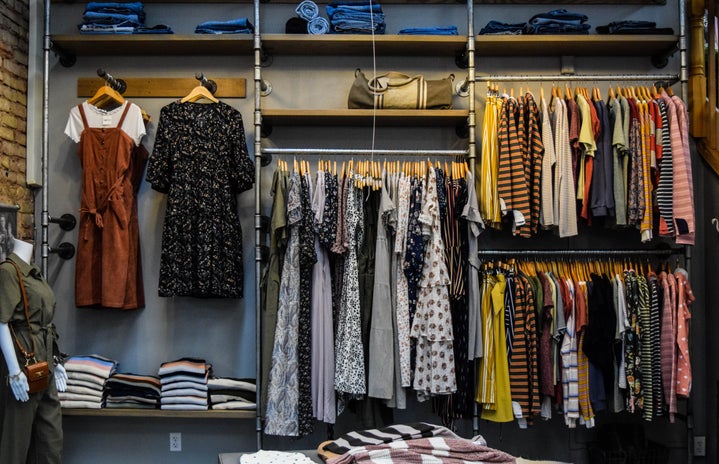Halloween is hands down my favourite time of year. I love everything about it: the scary movies, the pumpkins, the tiny chocolate bars, and the chance to wear costumes. When I was younger I would always ask my mom to help me put together my costumes, because I wasn’t content with a store-bought costume, I had to be the one to design it. To the surprise of no one, I’ve carried that with me as I’ve grown older, making and designing my own costumes — and not just for Halloween. I got involved with cosplay when I was fourteen, and have done some costuming work for a few local theatre groups; however, I have no formal training in sewing or costuming. I’m entirely self-taught. All this to say: you don’t have to be scared of making your own Halloween costume, and I’m going to give you some easy methods to do so!
-
Thrifting
Definitely the easiest way to start any costume is to get clothing that’s already made. Victoria has a huge Value Village downtown that I use to search for ready-made clothes I can alter for costumes. Many characters have outfits that can be pieced together with ready-made clothes and slight alterations. Additionally, if you plan to be a zombie or something similar you can buy cheap clothes at a thrift store to distress and splash with blood, rather than ruining nice clothes.
Me as Kageyama Shigeo from Mob Psycho 100 in a thrifted hoodie I hand-painted
-
Fabric shopping AKA from scratch
I won’t lie, making a costume completely from scratch is an undertaking and you should carefully check your schedule to make sure you’ll have enough time to actually make the costume. That being said, wearing a costume that you’ve made is super rewarding! Here in Canada, the big box store is Fabricland, and in America it’s JOANN Fabrics and Crafts. Of course, you can also find local fabric stores to shop at as well. Check the weight and feel of the fabric, not just the colour, and if you’re new to sewing, non-stretch is easier than stretch fabrics. Personally, I recommend only making from scratch what you can’t buy or alter; if you buy a white button-up for your vampire costume and only sew the lace you want on it, you’ll have more time to make the cape. Don’t be afraid to ask staff for help, or to buy a pattern.
Me as Haruka Nanase from Free! Iwatobi Swim Club wearing a cosplay made entirely from scratch
-
Alterations, painting, and more
So I’ve mentioned altering, painting, distressing, dumping blood on things… but I haven’t told you how to do any of these things. I won’t be going into super fine details, instead, I’m going to give you a general rundown that doesn’t require you to finely hone your skills or anything like that.
Staring with alterations, which are exactly what they sound like, altering an article of clothing. Adding iron-on patches, lace, cuffs, ruffles, decorative buttons, or adjusting the fit are all alterations. Last February I altered a yellow hoodie for a character by sewing in two small zippers —one at the top and one at the bottom —which only took me about twenty minutes. Have fun with altering things! Change out boring buttons for ones shaped like skulls, get lace with bats on it to edge your cape, use your imagination.
Painting is something I do entirely too much of. I’ve used fabric paint, but I haven’t found a brand I really like yet, so I mostly use acrylic paint. You cannot machine wash a costume you’ve made with acrylic paints, but that’s an easy price to pay, all things considered. You will need to put something underneath the fabric you’re painting, I use a large book with some plastic wrap or aluminum foil on it so the paint doesn’t ruin the book. The paint can take a while to dry so try to finish any painting at least the night before you need to wear whatever you’ve painted.
Distressing and dumping blood are both key for zombie, apocalypse, or otherwise beat up outfits. For distressing you can use scissors, steel wool, seam rippers, or any other sharp and/or abrasive tools you have lying around. Target hems, seams, places that see a lot of wear and tear like knees and elbows. You can easily find reference pictures of worn clothes online to help guide you. For adding blood, dirt, or other stains get creative. Flick a toothbrush for splatter, dab with a sponge for dappled mud, blend out your edges so stains look natural, and do not try to make fire damage with actual fire, that’s dangerous.
Left: Distressed and bloodied Alice in Wonderland dress
Right: Myself as Dirk Strider from Homestuck wearing a hand painted shirt
-
Makeup
Quite honestly, I think makeup is my weakest skill when it comes to dressing up; but it is important to touch on. Regardless of who or what you are dressing up as, or who or what you are in real life, makeup is a big part of dressing up. If you mix corn syrup and red food dye you have fake blood that’s safe to get in your mouth, and somehow fake blood always gets in your mouth; purple, red, brown, and blue eyeshadow can be blended together for bruise makeup; red lip liner is great for scratches, and if you add some red eyeshadow they’ll look inflamed; and if you really want to be ambitious you can get things like contacts, wigs, and prosthetics either from your local Halloween store or online.
Me as Dipper Pines from Gravity Falls with bruise makeup and fake blood
Me as Dipper Pines from Gravity Falls with bruise makeup, fake blood, and lip liner scratches
I hope this helps you put together an amazing Halloween costume. Share what you’re being for Halloween in the comments below! If you found this article helpful, and want me to write more about costuming things, put that in the comments too. Happy Halloween everyone!



